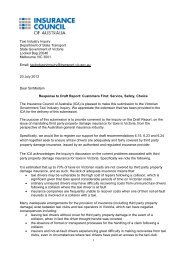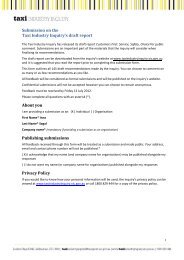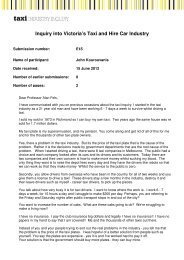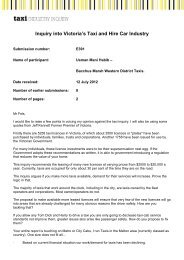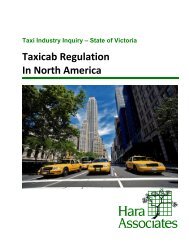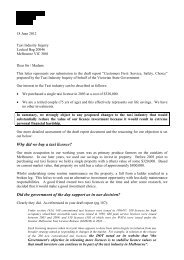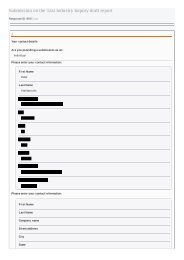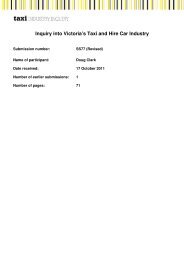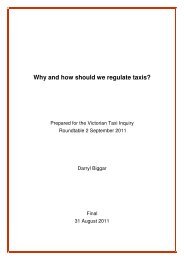Part D â Understanding and improving industry performance (PDF ...
Part D â Understanding and improving industry performance (PDF ...
Part D â Understanding and improving industry performance (PDF ...
Create successful ePaper yourself
Turn your PDF publications into a flip-book with our unique Google optimized e-Paper software.
Chapter 9.<br />
9. Alternative visions<br />
<strong>and</strong> approaches to<br />
taxi regulation<br />
Key messages<br />
• Worldwide, there are different approaches<br />
being used for taxi <strong>and</strong> hire car regulation.<br />
This gives Victoria an opportunity to learn from<br />
good <strong>and</strong> bad experiences in overseas cities<br />
<strong>and</strong> countries.<br />
• There is an international trend towards relaxation<br />
of regulatory controls that is consistent with<br />
open entry, setting maximum fares <strong>and</strong> an<br />
emphasis on <strong>improving</strong> driver <strong>and</strong> vehicle<br />
quality. In this context, while all systems involve<br />
regulation, the role for government <strong>and</strong> areas for<br />
regulatory focus vary widely between the highly<br />
restrictive <strong>and</strong> more open schemes.<br />
• In markets that have removed controls on<br />
entry to the taxi market, entry has usually<br />
been much greater than anticipated at the<br />
time of entry relaxation. This may reflect<br />
a number of different factors, including a<br />
significant level of unmet dem<strong>and</strong>, fares being<br />
set too high <strong>and</strong> over-optimism by drivers<br />
who want to become operators.<br />
• Based on available information, the inquiry’s<br />
view is that closed entry systems offer no<br />
discernable benefits over open entry systems<br />
in terms of better service quality or better<br />
remunerated drivers, but they have fewer taxis<br />
<strong>and</strong> likely higher levels of unmet dem<strong>and</strong>.<br />
• Few international jurisdictions have access<br />
to the depth <strong>and</strong> detail of information that is<br />
required to fully assess <strong>industry</strong> <strong>performance</strong>.<br />
• Better taxi <strong>and</strong> hire car systems make<br />
more effective use of competition <strong>and</strong><br />
promote efficiency.<br />
• Technology has the potential to greatly<br />
increase competition <strong>and</strong> efficiency.<br />
• Generally, while the immediate aftermath<br />
of entry liberalisation can be disruptive, the<br />
availability of taxis, service quality <strong>and</strong> the<br />
range of services offered improves over<br />
time, benefiting consumers, provided quality,<br />
safety <strong>and</strong> fare setting issues are dealt with<br />
appropriately in the new environment.<br />
Victoria is not alone in seeking to improve<br />
the <strong>performance</strong> of its taxi <strong>and</strong> hire car<br />
<strong>industry</strong>. Many other places around the<br />
world have experienced similar problems<br />
with point-to-point transport services <strong>and</strong><br />
a number have undertaken regulatory<br />
reform to address these concerns <strong>and</strong><br />
improve services for consumers.<br />
An investigation of Australian <strong>and</strong> international<br />
jurisdictions was carried out in accordance with the<br />
inquiry’s Terms of Reference which require the inquiry<br />
to ‘examine, evaluate <strong>and</strong> report on other models <strong>and</strong><br />
new approaches in the taxi <strong>and</strong> hire car sectors both<br />
in Australia <strong>and</strong> overseas’. This chapter summarises a<br />
selection of approaches to undertaking regulatory reform<br />
of taxi <strong>and</strong> hire car services, as well as different visions for<br />
the structure <strong>and</strong> operation of these services. 1<br />
Examining national <strong>and</strong> international models has enabled<br />
the inquiry to learn from the achievements <strong>and</strong> mistakes<br />
of other jurisdictions. This has assisted in forming the<br />
inquiry’s core findings <strong>and</strong> recommending the right<br />
reforms to shape a successful future for Victoria’s taxi<br />
<strong>and</strong> hire car <strong>industry</strong>.<br />
9.1. Overview of global trends<br />
Globally, there is no single ‘best practice’ model<br />
for regulation of taxi <strong>and</strong> hire car services. Different<br />
objectives are set <strong>and</strong> a variety of approaches adopted<br />
depending upon the political, spatial <strong>and</strong> dem<strong>and</strong><br />
characteristics of each place, as well as the general level<br />
of public transport services provided <strong>and</strong> extent of private<br />
vehicle ownership.<br />
9.1.1. Basic approaches to<br />
regulatory reform<br />
Essentially, there are two basic visions for taxi regulation:<br />
a restricted or ‘closed entry’ model <strong>and</strong> a liberalised or<br />
‘open entry’ model. These visions frame the discussion<br />
about regulatory reform, with most of the approaches<br />
adopted in other jurisdictions falling somewhere along the<br />
regulatory spectrum between these two extremes.<br />
Closed or restricted entry<br />
Closed or restricted entry models involve government<br />
restrictions on the number of taxi vehicles allowed to<br />
operate in the taxi market (beyond any restrictions implied<br />
by safety or other considerations).<br />
1 For further information, see Jaguar Consulting Pty Ltd (2012),<br />
Overview <strong>and</strong> analysis of possible transitional strategies: Moving<br />
from a tightly restricted supply model to an open entry taxi <strong>industry</strong> –<br />
Prepared for the Taxi Industry Inquiry, available at the inquiry’s website<br />
158





